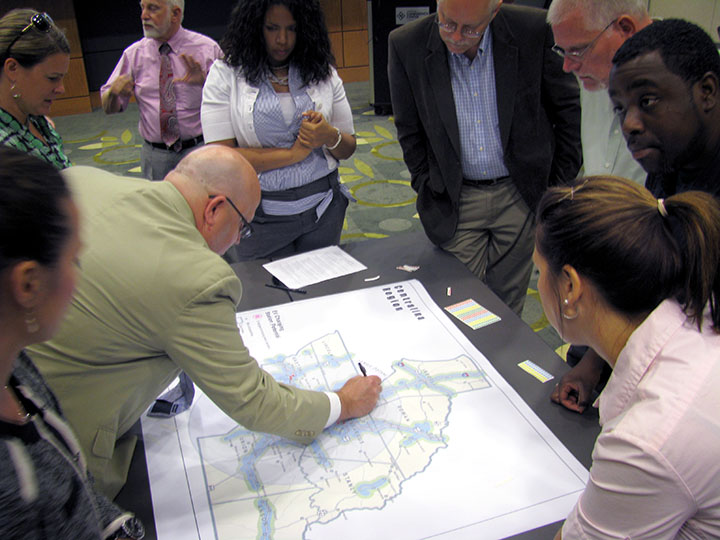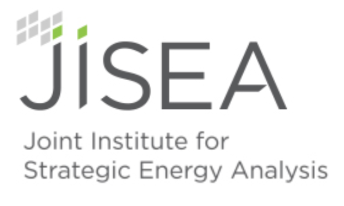Five Key Best Practices to Community Energy Planning

Stakeholders at a public meeting in Gastonia, North Carolina, provide input on locations for future development of electric vehicle charging stations. Photo from Centralina Clean Fuels Coalition
Aug. 17, 2022—More than 180 communities in the United States have committed to transition to 100% clean energy by 2050 or sooner. At the same time, some local communities are pushing back on the changes in land use and the development needed to transition to clean energy.
As a result, organizations such as the National Renewable Energy Laboratory (NREL) are increasingly called upon to provide energy planning assistance to communities. NREL has provided technical assistance to more than 2,000 communities, utilities, and businesses since 2010.
Building on decades of work with state, local, and tribal jurisdictions, NREL's partner, the Joint Institute for Strategic Energy Analysis (JISEA), published a new community energy planning best-practices guide to support practitioners at the laboratory and beyond. The guide was developed through the JISEA Sustainable Communities Catalyzer—an initiative that brings together thought leaders from JISEA, NREL, universities, and communities to leverage tools within sustainable communities research.
"As clean energy investments ramp up, demand for expertise in supporting communities in clean energy transitions is growing," said Megan Day, NREL analyst and lead of the Sustainable Communities Catalyzer. "We're excited to leverage our experience with thousands of communities and our rigorous, community-driven and science-based approach to provide this new best-practices guide. We hope it will enhance practitioners' capabilities in supporting community energy planning processes."
The guide offers five key best practices for community energy planning based on interviews with seasoned NREL practitioners and a literature review on equitable community energy planning:
1. Do Your Homework in Preparation for Community Interactions
Understanding as much of the community as possible before engaging enables practitioners to ask more meaningful questions, recognize unique needs across stakeholders, and build trust with community members. Spend time becoming familiar with the community's history, culture, people, structure, and energy resources before meetings. This will allow for specialized energy analysis that generates better options for the community.
2. Be Humble, Authentic, and Honest in Interactions With Community Members
Being humble, authentic, and honest in interactions with community members helps build trust, which is an essential component of equitable community energy planning. A key part of being authentic is approaching the work with a learning mindset and spending more time listening than talking.
Conversations with a community are part of the rigor of community energy planning. They can provide valuable information and data that play an important role in later stages of the planning process. Listening well in these collaborative discussions strengthens trust and can identify where there may be technology-inclusive solutions, as well as where those solutions are not possible.
3. Respect Community Agency in Every Step of the Process
Energy planning processes should build community agency, and the community's needs and goals should guide every step. Community-relevant qualitative and quantitative data should be integrated into decision-making models and tools. If the community has interest, you can also spend time teaching community members to use the models and tools, which might help them better prepare for future inquiries.
Community members should be involved in every part of the process. Solutions should be co-developed, including the technical assistance process itself. Remember to respond to the community's specific goals and questions instead of any predetermined ideas of what you think the community needs. Reflect on any preexisting assumptions you might bring to the planning process.
4. Meet the Community Where They Are
In community work, it is important to be flexible and meet the community where they are. Participation should be as easy as possible for community members. First, develop a shared language and understanding of terminology on energy and the community. This helps find common ground and ultimately better solutions that everyone supports. Energy planners join the community at their table, not the other way around; and on the community table, energy is integrated across a number of priorities. Be sure to give community members time and space to fully digest information, and develop strategies to compensate under-resourced community members for sharing their expertise.
5. Democratize Participation
The COVID-19 pandemic has presented many challenges to community energy planning, but it has also opened opportunities for more equitable processes. Virtual meetings can be more inclusive and reach a broader audience. More community members can be involved in the learning and data collection process. To democratize participation, consider scheduling several meetings a couple weeks apart and be mindful of nontraditional working hours. It's also important to allow participants to join by phone if they have low-bandwidth issues and to record and share presentations afterward.
Read the full best-practices guide to working with communities on clean energy planning.
Learn more about the JISEA Catalyzers initiative and NREL's work with state, local, and tribal governments.
Back to JISEA News >
